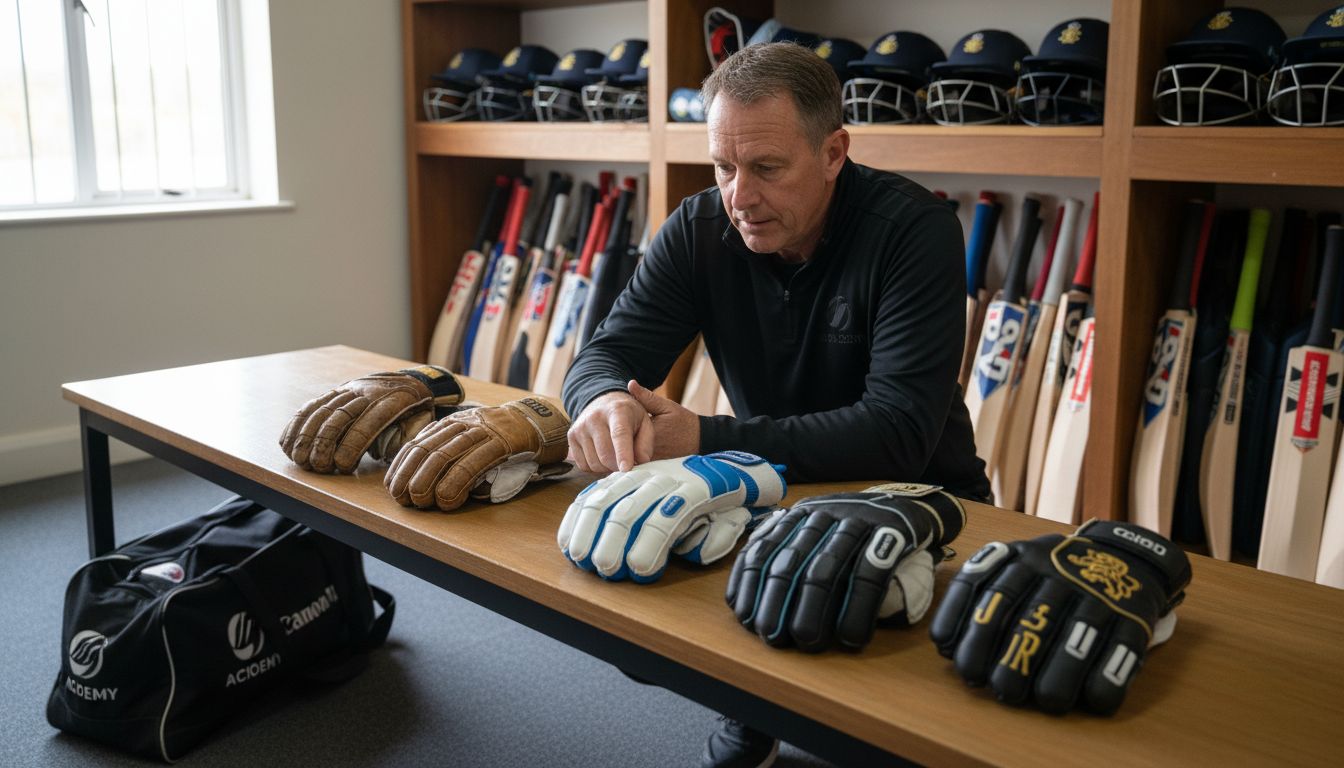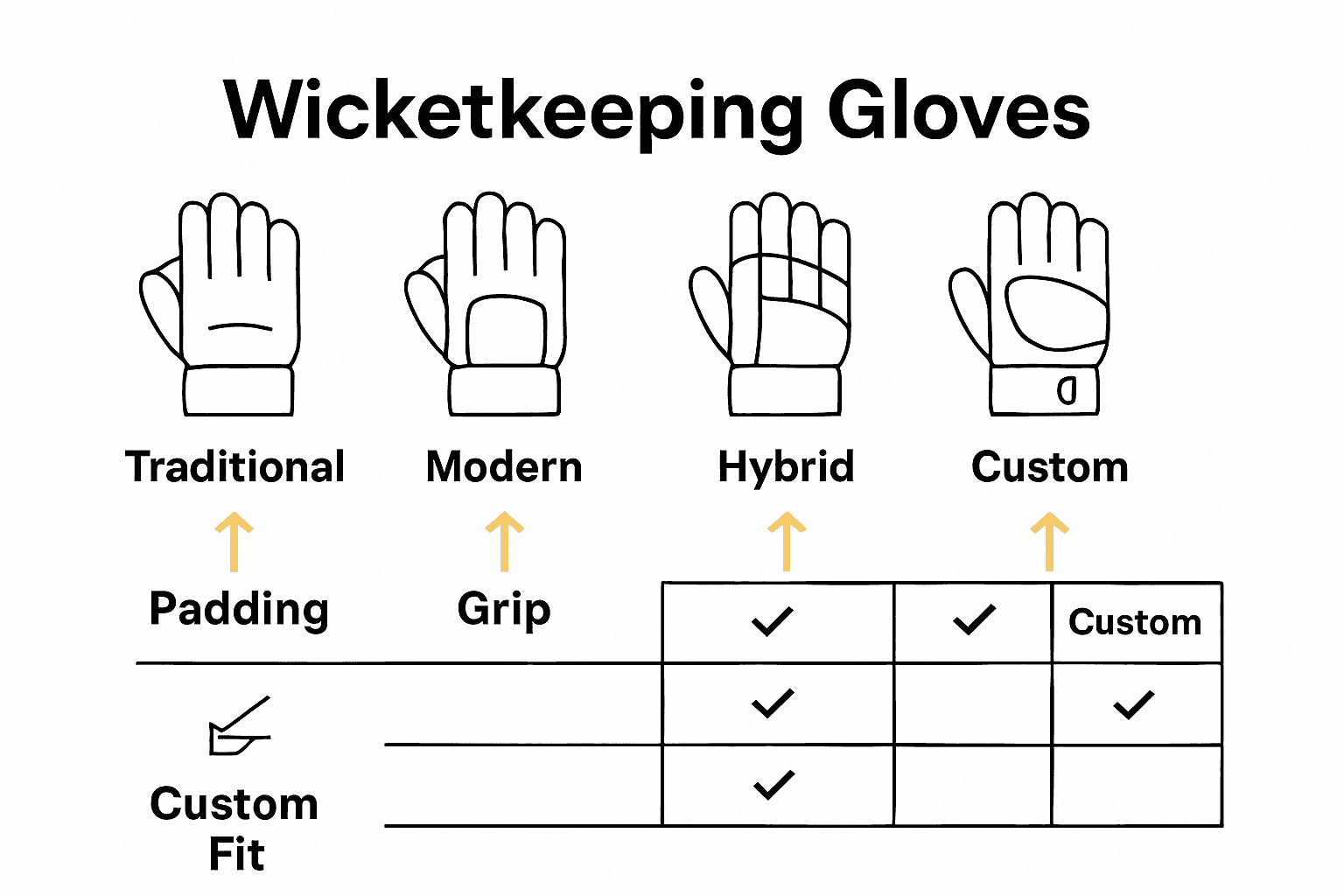Types of Wicketkeeping Gloves: Complete Guide

Over 90 percent of top cricket wicket-keepers credit their gloves for quick catches and powerful saves. For anyone serious about cricket, understanding wicketkeeping gloves goes beyond simple gear selection. These gloves combine advanced protection with precise grip, giving keepers the confidence and agility to make game-winning moves. Learn what makes these gloves unique, discover their different types, and find out how to choose the perfect pair for your playing style.
Table of Contents
- Defining Wicketkeeping Gloves and Their Role
- Major Types of Wicketkeeping Gloves Explained
- Essential Features and Levels of Protection
- How to Choose the Right Gloves for You
- Common Pitfalls and Alternatives Compared
Key Takeaways
| Point | Details |
|---|---|
| Role of Wicketkeeping Gloves | These gloves are essential for protective and performance-enhancing functions, allowing wicket-keepers to catch, stop, and execute game-changing plays effectively. |
| Types of Gloves | Wicketkeeping gloves can be categorized into traditional, modern, hybrid, and custom types, catering to various player preferences and playing styles. |
| Choosing the Right Gloves | Key factors in selecting gloves include fit, material quality, and padding, with many professional players also using inner gloves for added comfort and protection. |
| Common Pitfalls | Players often overlook the benefits of inner gloves and durability features, making informed selections essential for maximizing performance and longevity of the equipment. |
Defining Wicketkeeping Gloves and Their Role
In cricket, wicketkeeping gloves are specialized protective equipment designed for the unique and critical role of the wicket-keeper, the most specialized fielding position in the sport. According to Wikipedia, the wicket-keeper is the sole player on the fielding side permitted to wear gloves and external leg guards, highlighting the distinctive nature of this position.
These gloves are meticulously engineered to serve multiple essential functions. Wikipedia describes them as large leather gloves featuring a rubber catching surface with strategically placed traction-enhancing bumps. The internal soft padding is specifically designed to reduce impact when catching fast-moving cricket balls, protecting the wicket-keeper’s hands from potential injury.
The primary responsibilities of wicketkeeping gloves extend beyond mere protection. They are instrumental in enabling the wicket-keeper to perform crucial game-changing actions such as:
- Catching balls that pass the batsman
- Stopping deliveries with precision
- Executing stumpings when the opportunity arises
- Supporting potential run-out scenarios
Beyond their functional design, these gloves represent a critical piece of equipment that bridges the gap between defensive skill and tactical gameplay in cricket. The intricate design ensures that wicket-keepers can react swiftly and confidently, making split-second decisions that can dramatically influence the match’s outcome.
For cricket enthusiasts looking to understand more about specialized cricket equipment, check out our guide on understanding the role of gloves in cricket.
Major Types of Wicketkeeping Gloves Explained
When it comes to wicketkeeping gloves, players have several distinct types to choose from, each designed to meet different playing styles and performance requirements. According to Indian Players, wicketkeeping gloves can be broadly categorized into four primary types: traditional, modern, custom, and hybrid gloves.
Traditional Gloves represent the classic approach to wicketkeeping equipment. Crafted from high-quality leather with minimal padding, these gloves offer a pure, authentic feel that many experienced players appreciate. They provide a direct connection between the player’s hands and the cricket ball, allowing for a more tactile catching experience.
Modern Gloves have revolutionized wicketkeeping equipment by incorporating advanced materials and cutting-edge technologies. These gloves feature:
- Enhanced ergonomic designs
- Superior padding for impact protection
- Advanced grip technologies
- Lightweight materials that improve player mobility
The hybrid gloves present an intriguing middle ground, combining the best elements of traditional and modern design philosophies. By blending classic leather construction with contemporary padding and grip technologies, these gloves offer wicketkeepers a balanced approach to hand protection and performance.
Custom Gloves represent the pinnacle of personalization in wicketkeeping equipment. Players can tailor every aspect of their gloves, from material selection to specific padding configurations, ensuring a truly individualized piece of equipment that matches their unique playing style.

For cricket enthusiasts wanting to explore more about specialized cricket equipment, check out our comprehensive guide on understanding cricket gloves.

Essential Features and Levels of Protection
Wicketkeeping gloves are engineered with multiple sophisticated features designed to provide maximum hand protection and performance. According to Indian Players, these gloves incorporate advanced protective technologies, focusing on comprehensive hand safety during high-intensity cricket matches.
The primary protective components include specialized padding materials that absorb and dissipate impact energy. Foam and gel materials are strategically used to shield fingers and palms from potentially devastating hard ball deliveries. Fast Track Coaching highlights the diverse materials used in glove construction, including:
- Chamois Leather: Gentle, non-abrasive, with excellent absorption properties
- Natural Rubber: Offers stretchiness and waterproof characteristics
- Neoprene: Provides elasticity without latex
- Silicone Gel: Delivers strong shock absorption capabilities
Grip is another critical feature in wicketkeeping gloves. The palm area typically features latex or rubber surfaces with intricate texturing to minimize slippage during crucial catching moments. Additionally, modern gloves include individual finger protection systems, often incorporating protective spines to reduce the risk of finger fractures and bruising.
Wrist and fit security are equally important. Adjustable wrist straps and Velcro closures ensure a snug, personalized fit that prevents glove movement during dynamic wicketkeeping actions. This customization allows players to maintain maximum control and responsiveness while protecting their hands from potential injuries.
For cricket enthusiasts looking to dive deeper into protective equipment, check out our comprehensive guide on understanding cricket gloves.
How to Choose the Right Gloves for You
Selecting the perfect wicketkeeping gloves is a nuanced process that goes far beyond simple aesthetics. According to Heega Sports, professional wicket-keepers meticulously evaluate multiple critical factors when choosing their gloves, including fit, material, padding, and grip performance.
The foundation of an excellent pair of wicketkeeping gloves lies in proper fit and comfort. A well-fitted glove should feel like a second skin, allowing seamless hand movement while providing maximum protection. Many professional players employ an additional strategy: wearing inner or liner gloves beneath their primary gloves. These liner gloves, crafted from materials like cotton, chamois, and Lycra, serve multiple purposes:
- Absorb excess sweat
- Add extra cushioning against ball impact
- Improve overall grip consistency
- Enhance comfort during extended playing periods
Durability and design are equally important considerations. Modern wicketkeeping gloves feature advanced engineering, including bold stitching, reinforced seams, and UV-resistant coatings that extend the glove’s functional lifespan. When evaluating potential gloves, players should pay close attention to:
- Material quality
- Stitching integrity
- Padding thickness
- Grip texture
- Flexibility and range of motion
Ultimately, choosing the right wicketkeeping gloves is a personal journey that combines technical requirements with individual playing style. What works perfectly for one player might feel uncomfortable for another. Trying multiple options, understanding your specific needs, and prioritizing both protection and performance will guide you toward your ideal pair.
For more detailed guidance on selecting the perfect cricket equipment, check out our how to select cricket gloves guide.
Common Pitfalls and Alternatives Compared
Navigating the world of wicketkeeping gloves can be challenging, with numerous potential missteps that can compromise a player’s performance and protection. According to Heega Sports, many players unknowingly fall into critical selection traps that can significantly impact their game.
One of the most significant overlooked aspects is the importance of inner gloves. Many amateur players neglect to use liner gloves, missing out on crucial benefits. These inner gloves, made from materials like cotton, chamois, and Lycra, provide essential advantages:
- Sweat absorption
- Additional impact cushioning
- Improved grip consistency
- Enhanced overall comfort
Alternative approaches to traditional wicketkeeping gloves can help mitigate common performance issues. Players struggling with standard designs might consider:
-
Hybrid Glove Configurations
- Combining different materials for optimal protection
- Mixing traditional leather with modern synthetic materials
-
Customized Glove Solutions
- Tailored padding for individual hand shapes
- Specialized grip patterns for specific playing conditions
Durability remains a critical concern that many players overlook. Modern gloves address this with advanced features like bold stitching, reinforced seams, and UV-resistant coatings. These design elements prevent premature wear and extend the gloves’ functional lifespan, offering a more sustainable alternative to frequently replaced equipment.
For cricket players seeking to dive deeper into equipment selection, explore our comprehensive guide on selecting cricket gloves to avoid these common pitfalls and make an informed choice.
Discover Your Perfect Wicketkeeping Gloves at CricketKingdom.co.uk
Choosing the right wicketkeeping gloves is essential for maximizing your performance and protecting your hands from impact while staying comfortable. Whether you prefer traditional leather, modern padded designs, or customized options, understanding key features like fit, grip, and padding can make all the difference. Many players face frustration from poor glove choices that affect their confidence and game, but with the right support and gear, you can elevate your wicketkeeping skills.

Explore our extensive collection of high-quality wicketkeeping gloves and accessories at CricketKingdom.co.uk. Benefit from expert-curated selections, free shipping on orders over £100, and convenient payment options. Take the first step toward superior hand protection and unmatched performance by visiting our store and finding the gloves designed to match your unique style and needs. Start your journey to better wicketkeeping today with our complete guide to cricket gloves and shop with confidence at CricketKingdom.co.uk.
Frequently Asked Questions
What are the main types of wicketkeeping gloves?
Wicketkeeping gloves can be broadly categorized into four primary types: traditional, modern, custom, and hybrid gloves. Traditional gloves are made from high-quality leather with minimal padding, while modern gloves incorporate advanced materials and ergonomic designs. Hybrid gloves combine elements of both, and custom gloves allow for personalization to match individual playing styles.
How do I choose the right wicketkeeping gloves for my needs?
When choosing wicketkeeping gloves, consider factors such as fit, comfort, material quality, padding thickness, grip performance, and flexibility. It’s also advisable to try multiple options and consider wearing inner gloves for added comfort and protection during play.
What features should I look for in wicketkeeping gloves to ensure maximum protection?
Look for specialized padding materials that absorb impact, strong grip surfaces to prevent slippage, and adjustable wrist straps for a secure fit. Individual finger protection systems and durable construction, including reinforced seams, also enhance safety and longevity.
How do hybrid gloves differ from traditional and modern gloves?
Hybrid gloves combine the classic leather construction of traditional gloves with the advanced padding and grip technologies found in modern gloves. This design offers a balance between the tactile feel of traditional gloves and the enhanced protection and performance of modern gloves, making them suitable for a wider range of playing conditions.
Recommended
- Role of Cricket Gloves: Complete Guide for Players – The Cricket Kingdom
- 7 Essential Examples of Cricket Gloves for Every Player – The Cricket Kingdom
- Understanding the Types of Cricket Gloves: A Comprehensive Guide – The Cricket Kingdom
- Understanding the Role of Gloves in Cricket – The Cricket Kingdom


